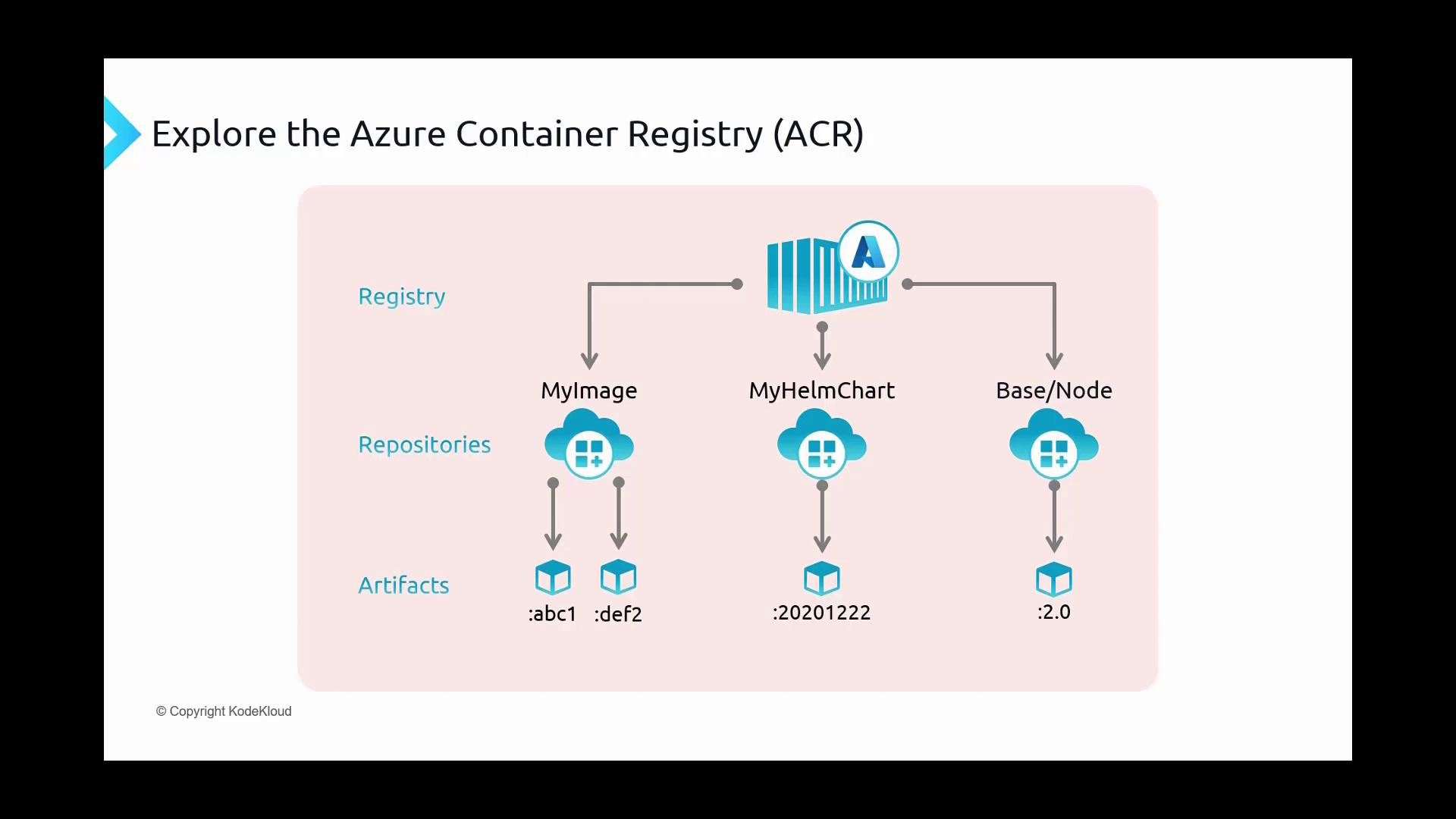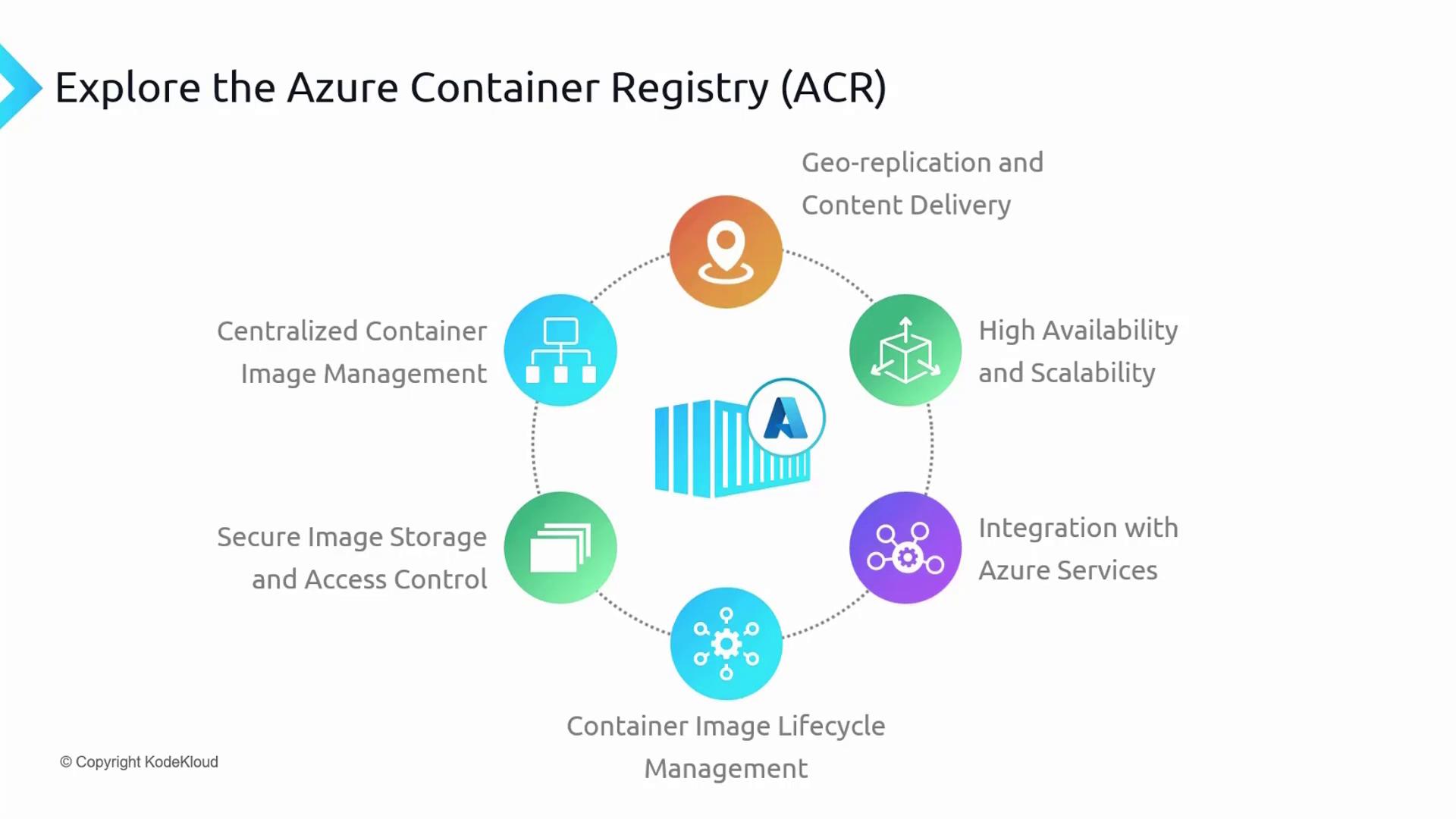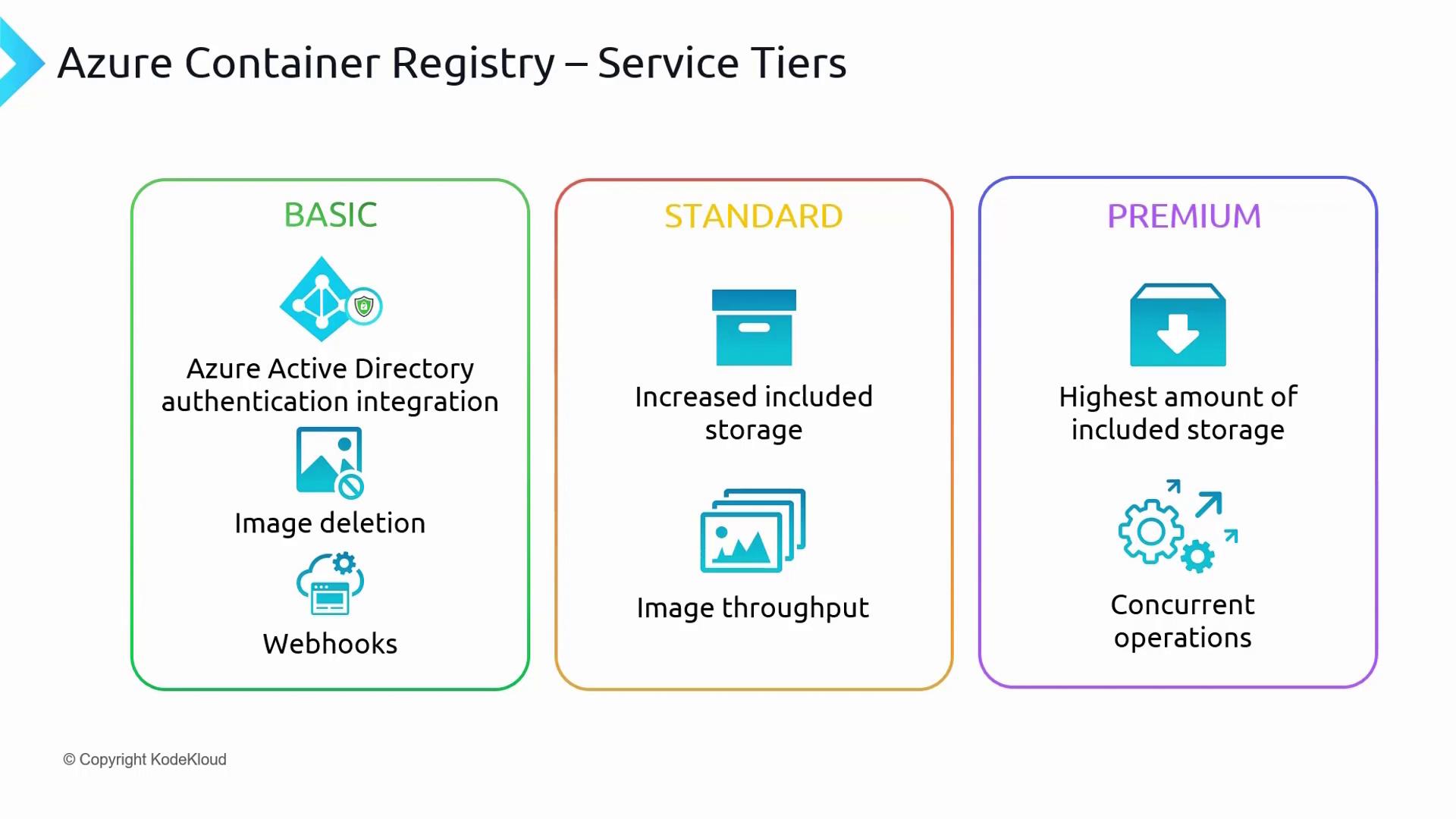Microsoft Azure Security Technologies (AZ-500)
Container Security
Explore the Azure Container Registry ACR
In this article, we dive into the Azure Container Registry (ACR), Microsoft Azure's managed Docker container registry service. ACR enables you to securely store and manage container images, Helm charts, and other artifacts directly within Azure. Integrated seamlessly with Azure DevOps and other popular CI/CD tools, ACR provides a reliable and scalable solution that streamlines the journey from source code to production containers.
Structure of Azure Container Registry
The structure of ACR is designed for simplicity and efficiency:
- Registry: The top-level storage solution that houses all containerized images.
- Repositories: Nested within the registry, repositories act as dedicated shelves for specific container images. They can include namespaces indicated by forward-slash-delimited names (for example, "base/node"). Although repository names might appear hierarchical, each repository is managed independently by the registry.
- Artifacts: Within each repository, artifacts represent specific versions or builds of container images or Helm charts that are uniquely identified by tags. These tags (such as "ABC1", "DEF2", or "20201222") correspond to different stages of your application or varying versions of a Kubernetes deployment package.

Building and Pushing a Docker Image to ACR
This section explains how to build a Docker image using a Dockerfile and push it to ACR.
Dockerfile Breakdown
The process starts with a Dockerfile that defines the blueprint for creating your Docker container image. Consider the following example:
FROM mcr.microsoft.com/dotnet/core/aspnet:3.0
WORKDIR /app
COPY published/aspnetapp.dll ./
ENTRYPOINT ["dotnet", "aspnetapp.dll"]
Dockerfile Instructions Explained
- FROM: Specifies the base image from the Microsoft repository, here using the .NET Core ASP.NET 3.0 image.
- WORKDIR: Sets the working directory inside the container to
/app. - COPY: Transfers the compiled
aspnetapp.dllfrom the published folder into the container. - ENTRYPOINT: Declares the command to run when the container starts (
dotnet aspnetapp.dll), launching the ASP.NET application.
When you run the docker build command with this file, Docker processes each instruction sequentially. Each command creates a distinct layer in the image, identified by a unique 256-character hash, which optimizes storage and version management.
Features of Azure Container Registry
ACR comes packed with several features that are crucial for efficient container management:
Centralized Container Image Management
ACR acts as a central hub for storing and managing your container images. It offers a secure environment equipped for organization and version-control, ensuring that your images are readily accessible for deployment across your infrastructure.
Secure Image and Access Control
Images in ACR are safeguarded with industry-standard encryption. Access is rigorously managed through Azure Active Directory, role-based access control, and fine-grained permissions, ensuring that your container images are protected from unauthorized access.
Container Image Lifecycle Management
ACR streamlines the management of container image lifecycles with features like versioning, environmental promotion, vulnerability scanning, and automated builds. These tools assist in maintaining a secure and efficient image management workflow.
Integration with Azure Services
ACR's deep integration with Azure Kubernetes Service and Azure DevOps simplifies the deployment of containerized applications. This seamless integration supports efficient CI/CD pipelines and smooth operations within your existing workflows.
High Availability and Scalability
Leveraging Azure’s robust global infrastructure, ACR offers high availability and scalability. It replicates images across multiple regions, reducing latency and ensuring fast image retrieval.
Geo-replication and Content Delivery

ACR supports geo-replication that allows you to mirror images across several Azure regions, enhancing redundancy and disaster recovery. Additionally, integration with the Azure Content Delivery Network (CDN) accelerates image distribution, improving global access speeds.
Creating an ACR and Pushing an Image
Follow these steps to create an ACR instance and push your image:
Create Your Dockerfile
Develop a Dockerfile that, for example, pulls the official Nginx image, installs necessary packages, downloads a Bootstrap template, and exposes port 80. See the sample Dockerfile below:# Use the official Nginx image as the base image FROM nginx:latest # Set working directory WORKDIR /tmp # Install required packages RUN apt-get update && \ apt-get install -y wget unzip && \ rm -rf /var/lib/apt/lists/* # Download and extract the HTML files RUN wget https://github.com/startbootstrap/startbootstrap-freelancer/archive/gh-pages.zip && \ unzip gh-pages.zip && \ mv startbootstrap-freelancer-gh-pages/* /usr/share/nginx/html/ && \ rm -rf /tmp/* # Expose port 80 EXPOSE 80Prepare Your Environment
Open the Azure Portal and start the Cloud Shell. Upload your Dockerfile to your home directory.Create a Container Registry
Run the following command in the Azure CLI to create a new container registry (replace<uniqueID>with your unique identifier):az acr create --resource-group RGACI --name acr<uniqueID> --sku StandardBuild and Push the Image
Use the command below to build the Docker image from your local Dockerfile and push it to the newly created ACR. The image is tagged as "bootstrap:v1":az acr build --image bootstrap:v1 --registry acr<uniqueID> .You'll see a build output similar to:
a7e2a768c198: Preparing 9c62615b1d98: Preparing ea43d4f82a03: Preparing 1dc45c680df: Preparing eb7e3384fab: Preparing d310e774110a: Waiting ea43d4f82a03: Waiting 1dc45c680df: Waiting eb7e3384fab: Waiting b74b4b382ff89: Pushed f3ca2b82a2c4: Pushed 9c62615b1d98: Pushed ea43d4f82a03: Pushed 1dc45c680df: Pushed d310e774110a: PushedAfter the build completes successfully, verify the image in your ACR via the Azure Portal under the "Repositories" section. You can also pull the image locally with:
docker pull acr<uniqueID>.azurecr.io/bootstrap:v1
Running the Container
Once you have confirmed the image is stored in ACR, deploy it as a container instance. For example, use the following command to pull the image:
docker pull acr<uniqueID>.azurecr.io/bootstrap:v1
After pulling the image, create a new container instance within the RGACI resource group. During the setup, ensure that the "admin user" is enabled in your ACR to facilitate authentication. Details on this configuration will be explained further in the ACR authentication section later in this series.
ACR Service Tiers
Before diving into ACR authentication, it’s important to understand the service tiers available for Azure Container Registry. The three primary tiers are:
| Service Tier | Description | Use Case |
|---|---|---|
| Basic | Provides core features for image storage, deletion, and webhook integration. | Suitable for development and low usage. |
| Standard | Offers increased storage and throughput over Basic, meeting most production requirements. | Ideal for most production workloads. |
| Premium | Delivers the highest storage capacity and throughput, plus additional features like geo-replication, content trust (image tag signing), and private link support. | Best for high scale, security, and redundancy needs. |

Choose the tier that best fits your workload requirements. You can start with Basic for initial testing, then scale up to Standard or Premium as your usage increases.
Next Steps
In the next lesson, we will explore ACR authentication in depth. You will learn how to configure and use the admin user alongside other authentication mechanisms to securely manage your container images.
Happy containerizing!
Watch Video
Watch video content